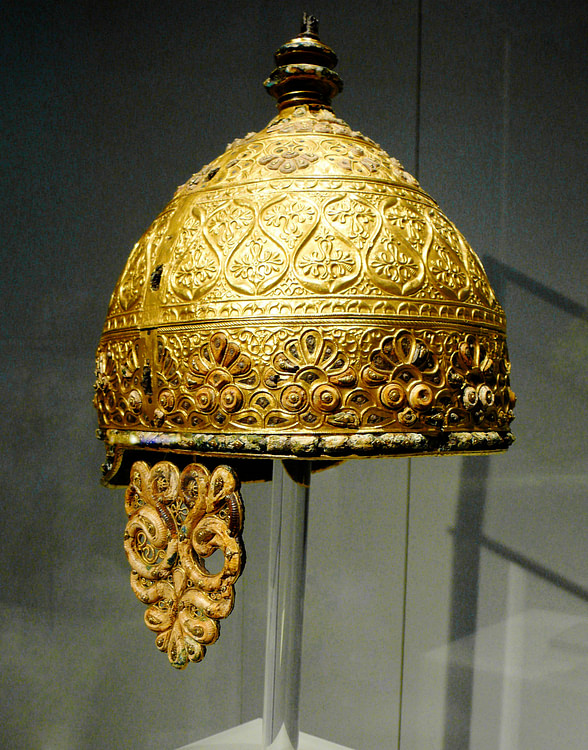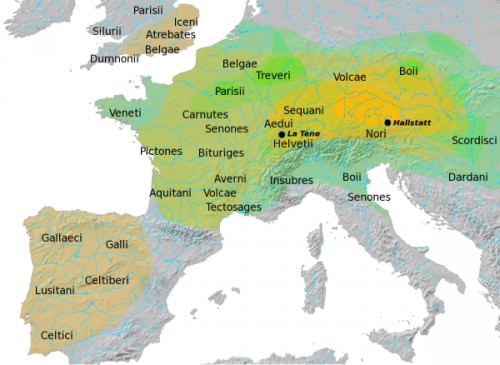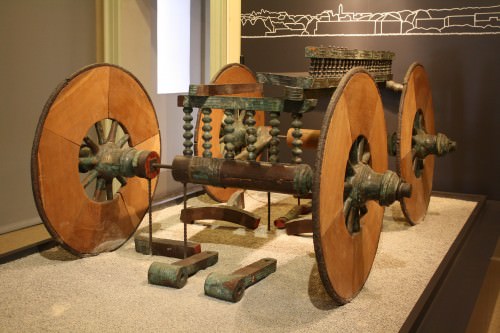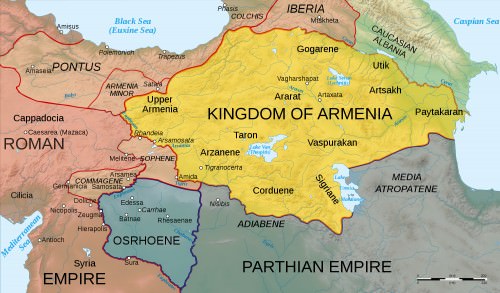Celts › Tiridates I of Armenia » Ancient origins
Articles and Definitions › Contents
- Celts › Antique Origins
- Tiridates I of Armenia › Who Was
Ancient civilizations › Historical and archaeological sites
Celts › Antique Origins
Definition and Origins

The ancient Celts were various population groups living in several parts of Europe north of the Mediterranean region from the Late Bronze Age onwards. Given the name Celt by ancient writers, these tribes often migrated and so eventually occupied territories from Portugal to Turkey. Although diverse tribes the ancient Celts spoke the same language and maintained the same artistic tradition which is characterised by the use of idiosyncratic flowing lines and forms. Celtic languages are still spoken today in parts of the British Isles and northern France.
GEOGRAPHICAL SPREAD
Ancient writers gave the name Celts to various population groups living across central Europe inland from the Mediterranean coastal areas. Most scholars agree that the Celtic culture first appeared in the Late Bronze Age in the area of the upper Danube sometime around the 13th century BCE. These early Celts were known as the 'Urnfield people' and they probably spoke a proto-Celtic language. By the 8th century BCE, iron had replaced bronze-working and the cultural group is then referred to by scholars as the 'Hallstatt culture'. Spain saw a similar development with tribes using iron weapons. The Hallstatt culture declined by the 5th century BCE, perhaps due to internal political tensions and economic difficulties. The next phase of Celtic development was carried out by a group known as the La Tène culture.
THE MIGRATION OF VARIOUS CELTIC TRIBES IN ORDER TO FLEE WARS MEANT THAT EVENTUALLY THEY OCCUPIED TERRITORY FROM THE IBERIAN PENINSULA TO TURKEY.
The prosperity of the La Tène culture in ancient France, Spain and wider central Europe meant that they were able to challenge the contemporary Mediterranean cultures and so they appear for the first time in Classical history. From then on these peoples were widely referred to as Celts. In antiquity writers did not describe tribes in ancient Britain and Ireland as Celts, although they have acquired that label in modern times and some Celtic languages or their derivatives are still spoken there, as a form of Celtic still is in the Brittany region of northern France. The religion of the Celts, led by a priesthood known as the Druids, is described by ancient writers with some disdain as crude and violent.
The migration of various Celtic tribes in order to flee wars – they were famously attacked in Gaul by Julius Caesar in the 1st century BCE and by the Germanic tribes - and find new prospects meant that eventually the territory occupied by them ranged from Galicia (the Iberian peninsula) to Romania. Many Celtic tribes spread eastwards, for example, traversing Macedonia in 280 BCE and crossing the Hellespont in 278 BCE into Asia Minor. The Galatians, as they were now called, colonised areas of central Asia Minor which brought them into direct conflict with both the Hellenistic kingdoms and Rome.

Hallstatt & La Tène Cultures
CELTIC WARFARE
Celtic armies first came to the attention of historians when the Gauls, led by their king Bran (Brennus), sacked Rome in 390 BCE, and again in 279 BCE when they looted Delphi as they passed through Greece on their way to Asia. The Celts attacked the Romans again in 225 BCE and were frequent mercenary allies of Carthage during the Punic Wars. The Celts thus gained a reputation with Latin and Greek writers for being fierce warriors and skilled horsemen who also fielded chariots in battle.Julius Caesar faced them when he invaded Gaul. They were light, pulled by two horses, and had an open front and back with double hoops at the sides. Containing two men they were used to attack enemy cavalry first by throwing javelins and then one man dismounted to fight on foot while the rider drove the chariot to a safe distance to await a retreat if necessary. Caesar describes them as driven with great skill and so were a highly manoeuvrable weapon of disruption and attack.
Celtic warriors were known for their long hair and imposing physique. They are depicted in Greek art with their distinctive long shields (wooden panels covered in decorated hide) and long swords. Such was the respect for Celtic warriors that Hellenistic kings who defeated Galatian armies were given the title of soter, meaning 'saviour'. Although Galatian armies were almost always defeated by their more disciplined and better-equipped enemies in single battles, once conquered, they did fight successfully as mercenaries in many Hellenistic and Roman armies.

Celtic Wagon
CELTIC LANGUAGES
The Celtic language is a branch of the Indo-European language family. Scholars have divided Celtic languages into two groups: Insular Celtic and Continental Celtic. The latter group was no longer widely spoken after the Roman imperial period, and the only surviving examples of it are mentions in the works of Greek and Roman writers and some epigraphic remains such as pottery graffiti and votive and funerary stelae. The best documented of this group is Gaulish.
The Insular Celtic group of languages are two: British or Brittonic (Breton, Cornish, and Welsh) and Goidelic (Irish and its medieval derivatives, Scots Gaelic and Manx). Brittonic was spoken in all of Britain in the Roman period. From it evolved Cumbrian (extinct since medieval times), Cornish (no longer spoken after the 18th century CE but recently revived), Breton (likely introduced by 5th-century CE British settlers and not connected directly to Gaulish), and Welsh, which is still spoken today. The earliest evidence of Goidelic-Irish dates to the 5th century CE, and it later evolved into Middle Irish (c. 950 – 1200 CE) and, thereafter, morphed again into Modern Irish, which is still spoken today.
Tiridates I of Armenia › Who Was
Definition and Origins

Tiridates I (Trdat I) ruled as the king of Armenia from 63 to either 75 or 88 CE). Considered the founder of the Arsacid dynasty proper, his reign got off to a rocky start with invasions from Rome and Parthia but, once crowned in a lavish ceremony in Rome conducted by Nero himself, the Armenian king would rule for a relatively peaceful and highly prosperous two decades.When exactly his reign ended is disputed due to conflicting ancient sources, but he was (probably) succeeded by his son Sanatruk II who continued with his father's success in balancing Armenia on the diplomatic tightrope it seemed destined to forever occupy between the region's two superpowers.
SUCCESSION
Tiridates I of Armenia was the brother of the Parthian king Vologases I (aka Vagharsh, rc 51- up to 80 CE, dates disputed) who invaded Armenia in 52 CE for the specific purpose of setting Tiridates on the throne. The Roman Empire was not, though, content to passively permit Parthia into what they considered a buffer zone between the two great powers. Further, an embassy arrived in Rome which represented the pro- Roman faction in Armenia and they asked for direct assistance.Consequently, Roman emperor Nero (r. 54-68 CE) sent an army under his best general Gnaeus Domitius Corbulo in 54 CE to restore Roman influence in the region.
TIRIDATES WAS SUPPORTED BY MOST OF THE ARMENIAN PEOPLE WHO WERE MORE SYMPATHETIC TO PARTHIA THAN TO ROME FOR HISTORICAL & CULTURAL REASONS.
First, Corbulo was given the task of securing both Syria and the small kingdom of Sophene (Dsopk) to beef up Rome's presence in the region and remind Parthia who they were up against. Then, when Parthia declared Armenia a vassal state in 58 CE, Corbulo moved northwards and attacked Armenia itself. By the time the Romans arrived in Tiridates' kingdom, Vologases had been forced to withdraw to deal with internal troubles in Parthia but Tiridates remained at the Armenian capital of Artaxata ( Artashat ). Tiridates was actually supported by most of the Armenian people who were more sympathetic to Parthia than to Rome for historical and cultural reasons.
Corbulo proved again to be a very capable field commander and with logistical support from Roman ships on the Black Sea, he took and destroyed the two most important cites - Artaxata and Tigranocerta. By 60 CE he could claim to rule over all of the kingdom of Armenia and Tiridates was forced to flee back to his brother in Parthia. In the same year, Tigranes V, who had impressive royal connections being the grandson of Herod the Great, was set on the throne as a pro-Roman monarch, but he would only last until the Parthians sent an army to besiege him in what was left of Tigranocerta. Thereafter, Tigranes disappears from the pages of history after the briefest of cameo appearances in the Armenian king lists.

Map of Armenia, 50 CE
In 62 CE Parthia won victory against a Roman army (significantly, perhaps, no longer commanded by Corbulo), but in 63 CE the Romans and Corbulo returned and their threat was sufficient for the Treaty of Rhandia to be drawn up (named after the site in western Armenia). It was now agreed that Parthia had the right to nominate Armenian kings, Rome the right to crown them, and both powers would rule equally over Armenia with the king as their representative. Nero was thus given the privilege of crowning Tiridates in Rome in a lavish spectacle that did much to show the power and global reach of the Roman Empire.
THE CORONATION OF TIRIDATES
In 66 CE, then, Tiridates symbolically presented his crown to an effigy of Nero and then travelled to the great city of Rome to receive it back again from the hands of the emperor. Taking a land route, an impressive entourage, which included the soon-to-be king's wife (wearing a golden helmet and face mask instead of a veil), his children, extended family and 3,000 courtiers, nobles, priests and bodyguards from Armenia, Parthia and Rome, plodded westwards. When Nero had offered to meet the travel expenses he had perhaps not imagined quite such a guest list. It was no surprise either that when the whole troupe arrived in Naples after nine months on the road, they were late. A round of gladiator and athletic games opened the festivities before the actual coronation in the Forum of Rome. There, kneeling before the emperor, Tiridates had to recite what would become the familiar eastern formula of submission:
Master…I have come to thee, my god, to worship thee as I do Mithras. The destiny thou spinnest for me shall be mine, for thou art my Fortune and my Fate. (Payaslian, 29)
Nero replied:
You have done well by coming here to enjoy my presence in person. What your father has not left to you and what your brothers did not preserve for you, I do accord to you, and I make you King of Armenia, so that you, as well as they, may know that I have the power to take away and to grant kingdoms. (Kurkjian, 78)

Roman Emperor Nero
The king was then crowned and allowed to sit on a throne next to Nero, albeit a slightly lower one than the Roman emperor's.The celebrations then continued in the Theatre of Pompey which Nero, true to form, had decked out completely in glittering gold and Tyrian purple canopies as a flamboyant imperial bonus. The Romans loved a spectacle and Tiridates' coronation certainly gave them one; indeed, thereafter, the day of the celebration carried the epithet “golden”. When the party was over Nero gave Tiridates a parting gift of 2 million sesterces and sent him on his way to rebuild Armenia.
A PROSPEROUS REIGN
With such a flurry of ancient sources gushing over Tiridates' coronation, it is rather disappointing that we know so little of the rest of his reign. We do know that the Romans next placed a handful of garrisons in the area to ensure the Treaty of Rhandia was adhered to but generally, there was, as planned by all three sides, a sustained period of peace.
AN INSCRIPTION FROM GARNI REVEALS THAT TIRIDATES WAS NOW CALLING HIMSELF “THE SUN” & “SUPREME RULER OF ARMENIA”.
The kingdom's prosperity, based on natural resources, agriculture and trade permitted Tiridates to build a new summer residence at Garni. A magnificent fortified complex built from white limestone, it boasted all the amenities of any palace anywhere in the Classical world. There were Roman baths, gardens, courtyards, mosaic -floored rooms and even a full-scale Roman temple for the king when in residence (which still stands today). An inscription from Garni reveals that Tiridates was now calling himself “the Sun” and “Supreme Ruler of Armenia”. Other notable projects of the period included the rebuilding of Artaxata after its destruction by Corbulo and which Roman writers record was renamed Neronia in honour of the king's great benefactor. A temple north of that city was dedicated to the god Tir. Finally, a number of estates were set aside by the king for pilgrims to pay homage to some of his relatives, after all, he was the Sun god Helios now. The agricultural production and consequent tribute from these sites also gave a handy boost to the royal treasury.
Notwithstanding the good times, there would soon be a reminder of Armenia's status as a client kingdom. Roman emperor Vespasian (r. 69-79 CE) made absolutely sure that no more territories in the region would fall to the Parthian ruling dynasty by annexing the kingdoms of Commagene and Lesser Armenia in 72 CE. In the same year (or perhaps the next) the nomadic Alani people temporarily invaded Armenia but Tiridates remained unscathed. There was perhaps also an Armenian invasion of Iberia (modern Georgia) but details are lacking in the now silent historical record.
SUCCESSOR & ARSACID DYNASTY
Tiridates I is considered the founder of the long-ruling Arsacid dynasty (Arshakuni) which would last until 428 CE. The dynasty had actually had its first king in 12 CE with the succession of Vonon (Vonones) but the instability of the Armenian throne and many short-reigning monarchs after Vonon has resulted in some historians taking Tiridates, with his more stable regime and that of his successors, as the true founder of the dynasty. When Tiridates died he was (probably) succeeded by his son Sanatruk II who would rule until 109 CE.
This article was made possible with generous support from the National Association for Armenian Studies and Researchand the Knights of Vartan Fund for Armenian Studies.
LICENSE:
Article based on information obtained from these sources:with permission from the Website Ancient History Encyclopedia
Content is available under License Creative Commons: Attribution-NonCommercial-ShareAlike 3.0 Unported. CC-BY-NC-SA License